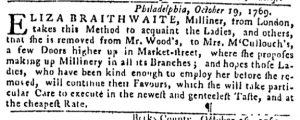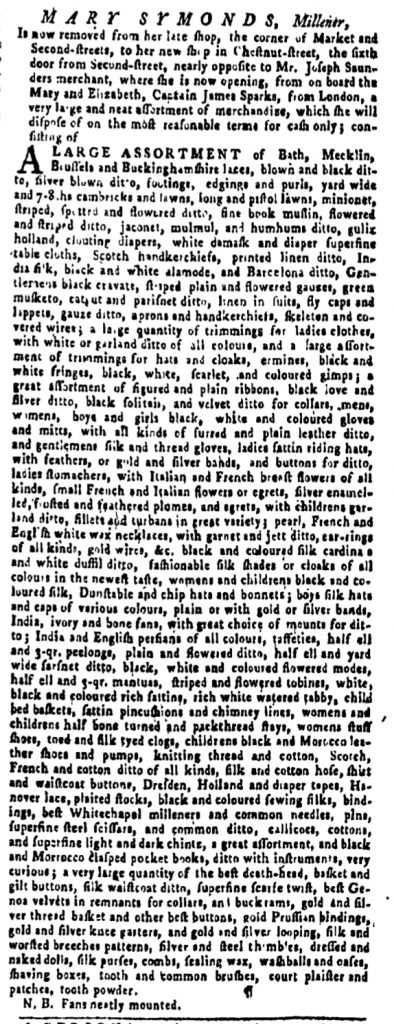What was advertised in a colonial American newspaper 250 years ago this week?

“Proposes to return as soon as the Importation is opened.”
Although many colonists promoted “domestic manufactures” as alternative to imported goods in the late 1760s and early 1770s, many consumers and purveyors of goods embraced those products only temporarily. Items produced in the colonies gained popularity when nonimportation agreements were in effect as a means of economic resistance to Parliament imposing duties on certain imported goods, but many colonists anticipated repeal of such odious legislation and looked forward to resuming business as usual. For some, domestic manufactures represented a temporary measure; merchants and shopkeepers intended to import goods from England once again when the political situation calmed, just as consumers intended to purchase those items as soon as they became available once again.
In the summer of 1770, Anne Pearson, a milliner in Philadelphia, was among those purveyors of goods who expressed enthusiasm about acquiring and selling imported merchandise once again. She placed an advertisement in the June 14, 1770, edition of the Pennsylvania Gazette to announce that she sought to liquidate her current inventory before traveling to London in the fall. She offered a “LARGE and general Assortment of Millinery and Linen-drapery Goods” at low prices. Yet Pearson did not plan to relocate to London; instead, she would stay for only a short time and then “return as soon as the Importation is opened” in the wake of the repeal of the duties on imported paper, glass, paint, and lead that had been established in the Townshend Acts. Some colonists continued to argue for the importance of domestic manufactures even after Parliament capitulated, but they did not sway purveyors or consumers to continue to abstain completely from imported goods. Recognizing the demand for such goods, Pearson attempted to put herself in the best position to serve customers in Philadelphia. Not only would she “return as soon as the Importation is opened,” she would bring with her “a fresh Assortment of the very best and most fashionable Goods.” In journeying to London to select those goods herself, Pearson seized an advantage over competitors who relied on English merchants and correspondents to supply them with goods. Pearson would not have to rely on the judgment of others, judgment that might be compromised by their desire to rid themselves of wares unlikely to sell in England. Instead, she could inspect the merchandise before placing her order and observe the current trends in London in order to make her case to prospective customers that she did indeed stock “the very best and most fashionable Goods” upon her return to Philadelphia.










